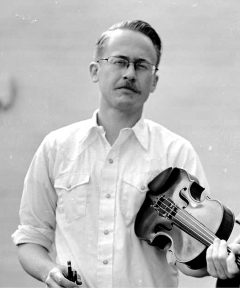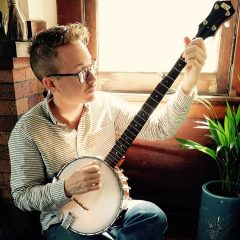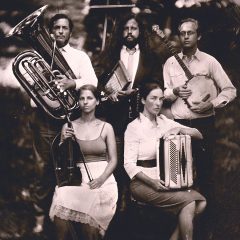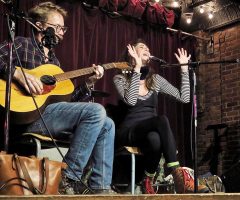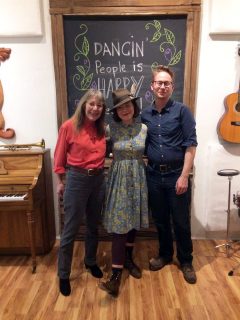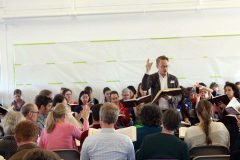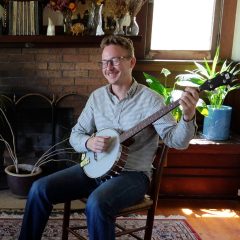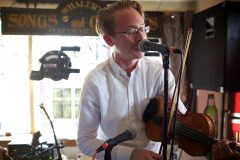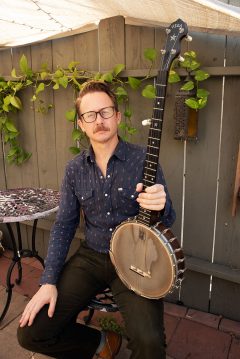Cover Story
Clinton Davis: Living Tradition
In our recent past, we had what some refer to as a folk revival. Musicians were turning off their amplifiers and reaching for their acoustic guitars. Mandolins and fiddles crept their way from the woodworks of bluegrass festivals into rock venues and were muscling out guitar solos and synthesizers on radio airwaves. Instruments like the accordion that had previously been relegated to the butt end of jokes suddenly were center stage in major popular touring acts. Americana exploded as an international phenomenon and, all of a sudden, instead of looking forward to innovation we were digging deeper into our own heritage to find inspiration. Out here on the West Coast our collective conscience wandered East—to the music of places like Appalachia and the Mississippi Delta. Our ears were pining for an honesty and authenticity that, as luck would have it, Clinton Davis had in spades.
Davis, in as little as a decade, has become an institution for old-time folk music in San Diego. If you have ever had the pleasure of witnessing him perform on what feels like a limitless list of instruments, you know exactly why. As a guitarist, Davis can reimagine ragtime piano pieces with such technical fluidity that you might start to wonder if Jelly Roll Morton had chosen the wrong instrument for his own compositions. On the banjo, Davis’ musical sensitivity unlocks an emotional palette that can swing from heart-wrenching delicacy to explosive excitement. He can make the mandolin scream and the harmonica wail (sometimes simultaneously!) in ways that feel both undeniably familiar and yet impossibly new. Recently, he spends much of his time on the fiddle, which in his hands speaks with its own unique vernacular and, much like the sound of his own voice, cuts right to the heart of the music with no need for frills or affectation.
As for the material he’s playing, Davis is a performer of old-time American folk music. As the name suggests, old-time music, along with the accompanying dances, is one of our nation’s longest-standing cultural traditions. Like most folk music, it is a predominantly oral tradition, with songs being passed down through generations and shared within a community of professionals and enthusiasts alike. It has distinctive pockets in the different regions of North America and, also, a relatively tight-knit national community. Some performers choose to focus on specific regions for their repertoire and style, some play a little bit of everything. Many, like Davis, fall somewhere in between.
It is important to note that unlike most other music cultures, there is little emphasis on writing new works in old-time music. Alternatively, artistry is developed primarily through the interpretation of pre-existing songs. As Davis notes, “On the one hand we all play this same repertoire, and it is a very vast repertoire. You know the exact boundaries of the repertoire can be fuzzy at times, but it’s this idea that we’re all playing the same tunes but there’s this really nice balance or tension between being faithful to it and developing a personal style within it.” In this tradition, there isn’t the same pedestal for the composition of new material as there would be in most other genres. In fact, many of the composers of favorite standards remain completely unknown. Instead, great artists develop their identity both through a curation of the songs they choose to play and the individual life they bring to this repertoire through their unique musical decisions. Davis describes the relationship between performers and the music: “When a really skillful player is performing, you are hearing them. You are hearing their creative ideas, you’re hearing their personality, but at the same time you’re also hearing a deep history that goes far beyond that individual.” This is a truly profound aspect of what a great artist does with the music. It focuses you in the moment, and in that moment you experience an epiphany of the past. Beyond any musical knowledge or technical prowess, this is the true magic that Davis creates—a marriage of ephemerality and timelessness.
Despite having carved out a specific niche for himself within the broader folk genre, Davis’ performances show a wealth of diversity within the old-time music tradition. I’ve been lucky enough to see it up close, having supported him on the guitar and bass over the years. If you’ve also been following Davis’ career, you’ve also witnessed an incredible spread: fiddle tunes from every corner of the United States, lonesome cowboy songs, jug band and blues tunes of many shades, old-timey gospel, murder ballads, train-wreck ballads, drinking ballads. Seriously, he’s got a ballad for just about anything, and though these stories predate Davis by generations, he sings them with the absolute clarity and sincerity that his audiences begin to crave. Take for instance, his version of “Man of Constant Sorrow” Having been popularized by the film O Brother, Where Art Thou?, there are countless versions, and it is often innocently but cluelessly requested as “the George Clooney song.” Despite the baggage the tune carries, Davis’ rendition is almost shockingly his own. Through his delivery, Davis has the ability to transform these stories and songs into something that is no longer an artifact of history, but a vessel through which he expresses himself and audiences can truly connect to their own humanity and community in present time.
It would be convenient to chalk up some of these talents to the fact that Davis is a fifth-generation Kentuckian from the relatively small town of Carrollton. As appealing as a story of geographical predetermination might seem, it really wouldn’t be telling the truth about his talents. He certainly was exposed to some things that many kids in California probably would not have the chance to experience, like the rich historic ties between Louisville and jug band music. And Davis’ father, being a guitar player, also had friends connected to some of the local legends of old-time music in the surrounding counties. But while Davis might’ve grown up in close proximity to musicians and documentarians that would later become the source of great inspiration and guidance, he was far from being immersed in the music that would later define his career. Instead, he grew up with the all-too-common feeling of a young person who needs to escape their hometown to discover something greater for themselves. So, long before he picked up a banjo or fiddle, he had set his sights on classical piano. Yep, that’s right folks, he also plays piano. Expertly well.
The study of the piano led Davis through his early life and on to pursue his undergraduate degree at the University of Kentucky. Although at this time performing classical works on the piano was his primary focus, he also had his first opportunity to really engage with old-time music through a university-sponsored concert series that brought musicians from the Appalachian tradition to perform in Lexington. As his interest grew, Davis made a trip to witness a square-dance held at a historic 200-year-old schoolhouse up in the mountains of eastern Kentucky, where the musicians had been performing and people had been dancing in much the same way they had for several decades. “I definitely was an outsider, and I felt like it… and the whole context seemed sort of foreign, but at the same time, to them it was so normal. And that was a powerful experience.” Despite the fact that he was not yet connected to the music the way he would become, in that gathering Davis witnessed something that wasn’t a reenactment or a revival, but in his words “a living tradition.” That being said, it would still be some time before Davis would be contributing his talents to that tradition.
After his undergraduate degree, he travelled across the country to further his studies at University of California, San Diego. Though he then loved, and still loves the music he had been studying, this is when his focus began to shift. “Everything about performing just brought with it much more intense psychological pressure… on a purely technical level it’s difficult music, in terms of scale it’s bigger, longer pieces… and on top of that there’s this cultural pedestal that classical music is put on.” Ultimately, the vision of performing as a classical pianist, let alone building a career as a classical pianist, began to feel too unpleasant a pursuit. He turned instead to the very timely research of… drumroll please… folk revivals. More specifically, he travelled various festivals and communities to study the revival of The Sacred Harp songbook, a collection of vocal music that has been preserved through a unique form of music notation. While it is not the kind of music Davis typically performs, Sacred Harp singing is the distinctive branch of old-time music that jump-started his new direction.
Meanwhile, the folk revival that was happening in popular music around the country was making its mark on the San Diego local music scene. Eager to join in this folk frenzy, a number of venues started hosting dedicated nights featuring Americana music. One of particular importance to Davis’ story was the Monday night Tin Can Country Club, hosted at the venue, which at that time was called the Tin Can Ale House. It was run with an intimate, curated open-mic format, and it attracted the local musicians who were digging deeper into the record collections for the older tunes and styles. You might hear anything from Townes Van Zandt to Leadbelly to the Carter Family in one short burst. For Davis, it was the perfect environment to begin performing the songs he had been studying, listening to, and loving for a receptive and similarly minded audience.
Starting from scratch isn’t easy. And now the same music student who had felt like an outsider at the square dance in eastern Kentucky was in a poetically similar, albeit musically opposite situation. He was, and remains, one of a small handful of musicians who specialize in old-time music in San Diego. Amid the much larger pool of acoustic musicians and singer songwriters that had a more modern sound, there was less of an infrastructure for him to climb within a scene specific to the old-time music he was playing. Nevertheless, he was eager to break into the broader San Diego music scene, so he made the wise choice not to go it alone. He reflected, “I thought at the time it would be easier to get people to notice and care at all if there was a band, as opposed to another guy with an acoustic guitar.” So, Davis enlisted an all-star group of friends and colleagues from UCSD, including Batya MacAdam-Somer on the violin; Meghann Welsh on the accordion, tenor banjo, and vocals; Jonathan Piper on the jug and tuba; and Sean Conway on washboard and other percussion. It was a particularly eclectic and potent ensemble.
The band that formed was the G Burns Jug Band. And Davis was right, people started to notice. Within a short time, Matt Parker, whom Davis described as “a real connoisseur of a broad range of culture,” invited G Burns to have a monthly residency at the Black Cat Bar, which Parker owns and operates in City Heights. It was serendipitous that, while many people in San Diego had still yet to hear of jug band music, Parker was already familiar with many of the songs and classic era jug bands that G Burns was inspired by. The residency was an anchor that allowed the band to develop its sound and expose this music to an audience in the early stages of the group.
The G Burns Jug Band quickly gained momentum. As more gigs picked up and records were released, the Jug Band was gaining more and more accolades, including a San Diego Music Award for their sophomore album, Southern Pacific & the Santa Fe, as well as a nomination for the follow up, The Fever. Sometime between the two records, the percussion role got switched out for guitar, played by yours truly. The success of the group culminated in a couple of important performances, namely a collaboration with living legend of jug band music—Jim Kweskin—and an invitation to perform at the National Jug Band Jubilee in Louisville, Kentucky. In more detail than I possibly could, Davis described this “full circle” experience of homecoming and career validation in depth in a previous article for the Troubadour. The G Burns Jug Band was also featured in a cover story in September 2015. (https://sandiegotroubadour.com/2015/09/g-burns-jug-band-tales-of-trains-tubas-and-washboards/) Both physically and artistically, the experience had brought Davis back to his Kentucky roots.
As the jug band’s success grew, so blossomed Davis’ individual career. He has performed at folk festivals all around the country. At the Santa Barbara Old Time Fiddler’s Convention, he has been awarded first prize on both the banjo, in 2018, and the fiddle, in 2019. These days, he is most likely to be performing solo or with his string band, featuring Nick Montemarano on the mandolin and Aaron Brownwood on the guitar. But he doesn’t always have to be the star of the show. Being a talented multi-instrumentalist, he also frequently collaborates with other like-minded musicians, such as Stephen Rey and Mara Kaye in San Diego, or groups like the Echo Mountain String Band and Skillet Licorice in Los Angeles and San Francisco, respectively.
A credit to his humble nature, Davis has made a point not to portray himself as an authority on the old-time music of Kentucky. Rather, he points to a few mentors of his, John Harrod and Clayton Dermon, whom Davis described as “the truest connection I have to that past.” Harrod, a fiddler from a neighboring county, traveled around Kentucky in the ’70 s and ’80s recording the songs and stylings of musicians that were still playing in the older tunes, thus creating an enormous library of Kentucky old-time music that might’ve otherwise been lost. For Davis, Harrod’s work is especially inspiring because it has injected Kentucky fiddle tunes that otherwise might have been forgotten into the greater old-time community. Similarly, Dermon is a family friend and musician who was connected with the players of the previous generation, many of whom unfortunately passed before Davis’ interest in the music had fully taken seed. Though the missed opportunity to meet these musicians is “particularly crushing” for Davis, he said he now takes every opportunity to spend time with Harrod and Dermon, absorbing the stories and music of their home state.
San Diego might not have ever been an epicenter for old-time music, but there have certainly been significant efforts to bring and foster folk music here. As far back as 1967, the late Lou Curtiss founded and operated the San Diego Folk Festival (now rebranded as Adams Avenue Unplugged), which brought a number of legendary performers. More recently, events like Gator by the Bay and concerts by the San Diego Folk Heritage have offered platforms for musicians from a number of American roots traditions. In spite of these efforts, Davis had noticed an unfortunate pattern when it came to the tour routing of old-time groups: many came to California, but rarely would anyone perform south of Los Angeles.
Davis seized the opportunity and with the help of co-conspirator Nick Montemarano created the Southern Pacific Sessions. Since 2017, the series has hosted artists from every corner of the country, allowing San Diegans the opportunity to experience these national treasures in an intimate setting. The impact has been beneficial for everyone. For many of these national traveling acts, it has opened up a new market for touring. For San Diego, Southern Pacific Sessions has put the city back on the radar of the national old-time scene. For Davis, Southern Pacific Sessions is an opportunity to connect with and hear live some of the performers he admires most, without having to travel far and wide to do so.
Besides performing and presenting live concerts, Davis involves himself in a host of other projects. He is currently in the middle of tracking another solo album set to be released next year on David Bragger’s record label, Old-Time Tiki Parlour. In the wake of the pandemic, he has amped up his remote recording work, recently contributing his talents to recordings with Mara Kaye, Al Howard, and Stephen Rey, as well as his more geographically distant colleagues in Skillet Licorice. Just in case you’re making a record and weren’t keeping tabs, I’d like to remind you that his arsenal includes the banjo, violin, guitar, piano, mandolin, and harmonica. What’s more, he can teach you any of those instruments, and trust me—he knows a thing or two about educating. He doesn’t like to flaunt it (again, humble) but this guy has a Ph.D. in music, and he knows how to use it. He is now offering private lessons online to anyone around the world, and if you know what’s good for you, you can schedule a free consultation through his website.
Davis, through his performance, teaching, research, and concert series, has become a beacon of old-time music in San Diego. Some are thrust into that role by external pressure, others are brought to it through their personal enjoyment. As Davis explained, “I don’t know if I feel a responsibility to do it, but it is something I want to do…I definitely feel an urgency when it comes to the music of my hometown and where I grew up—trying to understand and preserve something of that.” On a more personal note, “both sides of my family have been in that same county for at least five generations, and that chapter of my family’s history looks like it is probably going to end with me.” His dedication is personal, but more than anything it is driven by a deep love for the music. It shines through in everything he does. He is without a doubt one of the Finest City’s finest folk musicians. He doesn’t need to dress up to tell his stories, or overact to rile up an audience. Through him the music flows naturally and honestly and it becomes obvious that these are not artifacts of a forgotten past, but indeed part of a vibrant living tradition.
Continue listening with this “hometown tune”:
https://www.youtube.com/watch?v=VDPE7hPu3cs&feature=youtu.be
Follow Clinton Davis:
Youtube: https://www.youtube.com/c/ClintonDavisMusic
Instagram: @clintonrossdavis
For Lessons:






